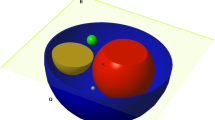Abstract
In the Wicksell corpuscle problem, the maximum size of random spheres in a volume part is to be predicted from the sectional circular distribution of spheres cut by a plane. The size of the spheres is assumed to follow the generalized gamma distribution. Some prediction methods according to measurement methods on the sectional plane are proposed, and their performances are evaluated by simulation. The prediction method based on the r largest sizes and the total number of the sectional circles is recommended, because of its satisfactory performance.
Similar content being viewed by others
References
Cohen, J. P. (1982). Convergence rates for the ultimate and penultimate approximations in extreme-value theory, Adv. in Appl. Probab., 19, 1811–1825.
de Haan, L. (1970). On Regular Variation and Its Application to the Weak Convergence of Sample Extremes, Mathematical Centre Tracts, 32, Amsterdam.
Drees, H. and Reiss, R.-D. (1992). Tail behavior in Wieksell's corpuscle problem, Probability Theory and Applications: Essays to the Memory of József Mogyoródi (eds. J. Galambas and I. Kátai), 205–220, Kluwer, Dordrecht.
Galambos, J. (1987). The Asymptotic Theory of Extreme Order Statistics, 2nd ed., Krieger, Melbourne.
Hughey, R. L. (1991). A survey and comparison of methods for estimating extreme right tail-area quantiles, Comm. Statist. Theory Methods, 20, 1463–1496.
Murakami, Y. (1993). Metal Fatigue: Effects of Small Defects and Nonmetallic Inclusions, Yokendo, Tokyo (in Japanese).
Murakami, Y. (1994). Inclusion rating by statistics of extreme values and its application to fatigue strength prediction and quality control of materials, J. Res. Nat. Inst. Standards Tech., 99, 345–351.
Pickands, J. (1975). Statistical inference using extreme order statistics, Ann. Statist., 3, 119–131.
Smith, R. L. (1986). Extreme value theory based on the r largest annual events, Journal of Hydrology, 86, 27–43.
Smith, R. L. (1987). Estimating tails of probability distributions, Ann. Statist., 15, 1174–1207.
Takahashi, R. and Sibuya, M. (1996). The maximum size of the planar sections of random spheres and its application to metallurgy, Ann. Inst. Statist. Math., 48, 127–144.
Weissman, I. (1978). Estimation of parameters and large quantiles based on the k largest observations, J. Amer. Statist. Assoc., 73, 812–815.
Wicksell, S. D. (1925). The corpuscle problem. A mathematical study of a biometric problem. Biometrika, 17, 84–99.
Author information
Authors and Affiliations
About this article
Cite this article
Takahashi, R., Sibuya, M. Prediction of the Maximum Size in Wicksell's Corpuscle Problem. Annals of the Institute of Statistical Mathematics 50, 361–377 (1998). https://doi.org/10.1023/A:1003451417655
Issue Date:
DOI: https://doi.org/10.1023/A:1003451417655



